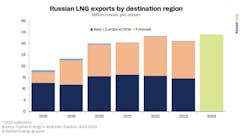Sam Fletcher
OGJ Senior Writer
HOUSTON, June 21 -- After declining in the previous session, the front-month contract for benchmark US crudes ticked up 0.3% June 20 in the New York market on hopes Greece will monetize state assets to prevent default on sovereign debt that would injure the global economy.
“Despite a stronger broader market and crude prices, energy stocks remained relatively flat,” said analysts in the Houston office of Raymond James & Associates Inc.
Olivier Jakob at Petromatrix, Zug, Switzerland, reported, “West Texas Intermediate started the day trading below the 200-day moving average but very strong bidding right on the start of the open session made sure that it would move back above that level. The Standard & Poor’s 500 index also confirmed the support of the 200-day moving average, although it was done in an environment of very low volume.”
The price spread between Brent and WTI continued to narrow from the “extreme premium” of last week, he said. “The fluctuation in that ‘arbitrage spread’ continues to be as or more important than flat price,” said Jakob. “This should not qualify the spread to be trading with a lower exchange margin than flat price, and we are not sure for how long will the exchanges be able to offer such a discount on the initial and maintenance margin to trade the Brent-WTI.”
James Zhang at Standard New York Securities Inc., the Standard Bank Group, said, “The term structure for Brent weakened significantly, with the Brent December 2011-December 2012 spread losing 80¢/bbl yesterday and $2.90/bbl since…May 11. Oil products mostly followed Brent and traded lower yesterday. On the back of lower oil product prices, European refining margins remain weak. US margins look healthier.”
He said, “The Commodity Futures Trading Commission report yesterday shows that investors are more cautious now towards the oil market than a few months ago, following signs of lower economic growth. The ongoing euro-zone crisis is also weighing down the market. Commercial hedgers are also more reluctant to hedge their production after the recent fall in oil prices.”
Zhang said, “Rather weak refining margins pose further downside risk to crude prices in the near term, unless product demand growth [regains] some momentum to lead oil prices up.
In other news, Jakob said, “The pressure on the Keystone and the Enbridge pipelines is being reduced to make sure that further leaks do not occur, and this should reduce some of the overall volume of Canadian crude oil moving to the Midwest. On the other hand, the surge of Brent to Light Louisiana Sweet last week had created arbitrage economics that would put pressure on the European crude oil markets.”
Energy prices
The July contract for benchmark US light, sweet crudes—scheduled to expire at the close of the June 21 session—regained 25¢ to $93.26/bbl June 20 on the New York Mercantile Exchange. The August contract increased 23¢ to $93.63/bbl. On the US spot market, WTI at Cushing, Okla., was up 25¢ to $93.26/bbl.
Heating oil for July delivery lost 5.13¢ to $2.93/gal on NYMEX. Reformulated blend stock for oxygenate blending for the same month decreased 3.45¢ to $2.91/gal.
Natural gas prices continued to decline with the July contract dipping 0.8¢ to $4.32/MMbtu on NYMEX. On the US spot market, gas at Henry Hub, La., fell 5.4¢ to $4.35/MMbtu.
In London, the August IPE contract for North Sea Brent crude dropped $1.52 to $111.69/bbl. Gas oil for July continued its downward course, losing $7.55 to $932.50/tonne.
The average price for the Organization of Petroleum Exporting Countries' basket of 12 reference crudes was down 10¢ to $107.41/bbl.
Contact Sam Fletcher at [email protected].

